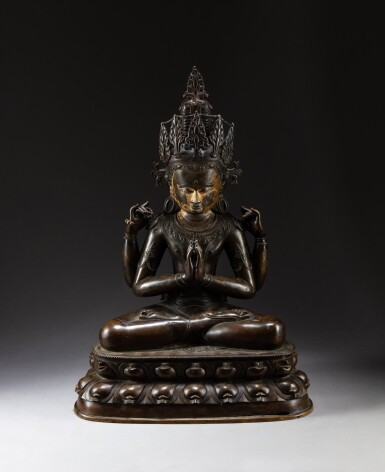Arts d'Asie
Arts d'Asie

A copper-alloy figure of Sadaksari Avalokitesvara Central Tibet, ca. 14th century | 西藏 約十四世紀 局部鎏金銅合金四臂觀世音菩薩坐像
Auction Closed
June 16, 02:39 PM GMT
Estimate
40,000 - 60,000 EUR
Lot Details
Description
A copper-alloy figure of Sadaksari Avalokitesvara
Central Tibet, ca. 14th century
with traces of cold gold on the face and neck
H. 56.5 cm, 22 1/4 in.
__________________________________________________________________________
Sculpture de Sadaksari Avalokitesvara en alliage de cuivre partiellement doré, Tibet, vers XIVe siècle
__________________________________________________________________________
西藏 約十四世紀 局部鎏金銅合金四臂觀世音菩薩坐像
Often thought to have a western Tibetan origin, this type of early Tibetan sculpture is more likely to be from the central regions where the primary stylistic influence was the art of eastern India during the Pala period (8th-12th c). Features in the Pala idiom include the tall crown panels, the necklace of pendant gems with an elaborate central jewel setting, and the fishtail scarf-ends of the crown- and belt-ties: compare the tall crown panels and necklace type of a ca. 12th century eastern Indian standing Buddha from Kurkihar see Susan L. Huntington, The Pala-Sena Schools of Sculpture, Leiden, 1984, pl. 185. The Pala influenced style seems to have been popular in Tibet from around the twelfth through the fourteenth century, about the same time period that strong eastern Indian influence is seen in central Tibetan painting. The bronzes in this style are mostly un-gilded, like their Indian antecedents. Central Tibetan sculpture after the fourteenth century is increasingly gilded in the Nepalese manner. Compare a similar fourteenth century Vairochana in the Berti Aschmann Collection at Museum Rietberg, with tall crown leaves, the same type of necklace with large central element and gem-set pendants, and arm bands with beaded swags, all so typical of this early central Tibetan sculptural group, see Helmut Uhlig, On the Path to Enlightenment, Zürich, 1995, p. 65, cat. 25. The four-armed bodhisattva holds a rosary and flower stem in his upper hands, with his principal hands held together before the chest in the gesture of salutation, anjali mudra. Sadaksari Avalokiteshvara is often regarded as the patron of Tibet and the progenitor of the Dalai Lama lineage.
